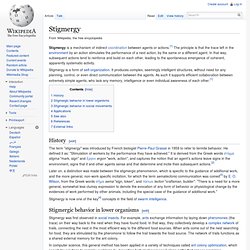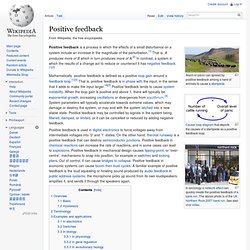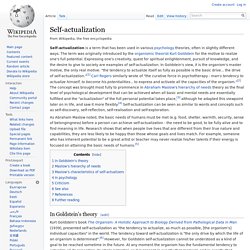

Social complexity. Generative science. Interaction between a few simple rules and parameters can produce endless, unpredictable complexity Generative science is an interdisciplinary and multidisciplinary science that explores the natural world and its complex behaviours as a generative process.

Generative science shows how deterministic and finite rules and parameters in the natural phenomena interact with each other to generate seemingly unanticipated and infinite behaviour. Yet, these innumerable unforeseen generative patterns and unexpected generative behaviours are fundamentally deterministic. Elemental perspective[edit] Generative sciences explore natural phenomena at several levels[1] including physical, biological and social processes as generative processes.[2][3][4][5][6][7] It explores complex natural processes through continuous interactions among elemental entities based upon parsimonious and simple universal rules and parameters.[2][3][4][5][6][7] Scientific and philosophical origins[edit] In 1996 Joshua M.
W. Process philosophy. Process philosophy (or ontology of becoming) identifies metaphysical reality with change and development.

Since the time of Plato and Aristotle, philosophers have posited true reality as "timeless", based on permanent substances, while processes are denied or subordinated to timeless substances. If Socrates changes, becoming sick, Socrates is still the same (the substance of Socrates being the same), and change (his sickness) only glides over his substance: change is accidental, whereas the substance is essential. Therefore, classic ontology denies any full reality to change, which is conceived as only accidental and not essential. Dynamics. Stigmergy. Stigmergy is a mechanism of indirect coordination between agents or actions.[1] The principle is that the trace left in the environment by an action stimulates the performance of a next action, by the same or a different agent.

In that way, subsequent actions tend to reinforce and build on each other, leading to the spontaneous emergence of coherent, apparently systematic activity. Stigmergy is a form of self-organization. It produces complex, seemingly intelligent structures, without need for any planning, control, or even direct communication between the agents. As such it supports efficient collaboration between extremely simple agents, who lack any memory, intelligence or even individual awareness of each other.[1] History[edit] The term "stigmergy" was introduced by French biologist Pierre-Paul Grassé in 1959 to refer to termite behavior. Visual control. Visual control is a business management technique employed in many places where information is communicated by using visual signals instead of texts or other written instructions. The design is deliberate in allowing quick recognition of the information being communicated, in order to increase efficiency and clarity.
These signals can be of many forms, from different coloured clothing for different teams, to focusing measures upon the size of the problem and not the size of the activity, to kanban, obeya and heijunka boxes and many other diverse examples. In The Toyota Way, it is also known as mieruka. Purpose[edit] Visual control methods aim to increase the efficiency and effectiveness of a process by making the steps in that process more visible. There are many different techniques that are used to apply visual control in the workplace. Visual controls are designed to make the control and management of a company as simple as possible. Intercultural competence. A theoretical construct for cross-cultural competence, language proficiency, and regional expertise.

Intercultural competence is the ability to communicate effectively and appropriately with people of other cultures:[1] Appropriately. Valued rules, norms, and expectations of the relationship are not violated significantly.Effectively. Valued goals or rewards (relative to costs and alternatives) are accomplished. In interactions with people from foreign cultures, a person who is interculturally competent understands the culture-specific concepts of perception, thinking, feeling, and acting. Intercultural competence is also called "cross-cultural competence" (3C). The Origins of Good Ideas. Positive feedback. Alarm or panic can spread by positive feedback among a herd of animals to cause a stampede.

Positive feedback is a process in which the effects of a small disturbance on a system include an increase in the magnitude of the perturbation.[1] That is, A produces more of B which in turn produces more of A.[2] In contrast, a system in which the results of a change act to reduce or counteract it has negative feedback.[1][3] Overview[edit] Positive feedback enhances or amplifies an effect by it having an influence on the process which gave rise to it. Basic[edit] A basic feedback system can be represented by this block diagram. Emergentism. In philosophy, emergentism is the belief in emergence, particularly as it involves consciousness and the philosophy of mind, and as it contrasts (or not) with reductionism.

A property of a system is said to be emergent if it is in some sense more than the "sum" of the properties of the system's parts. An emergent property is said to be dependent on some more basic properties (and their relationships and configuration), so that it can have no separate existence. However, a degree of independence is also asserted of emergent properties, so that they are not identical to, or reducible to, or predictable from, or deducible from their bases.
The different ways in which the independence requirement can be satisfied lead to variant types of emergence. Self-actualization. Self-actualization is a term that has been used in various psychology theories, often in slightly different ways.

The term was originally introduced by the organismic theorist Kurt Goldstein for the motive to realize one's full potential. Expressing one's creativity, quest for spiritual enlightenment, pursuit of knowledge, and the desire to give to society are examples of self-actualization. In Goldstein's view, it is the organism's master motive, the only real motive: "the tendency to actualize itself as fully as possible is the basic drive... the drive of self-actualization. "[1] Carl Rogers similarly wrote of "the curative force in psychotherapy - man's tendency to actualize himself, to become his potentialities... to express and activate all the capacities of the organism. Self-realization. Self-realization is an expression used in psychology, spirituality, and Eastern religions.

In one overview, Mortimer Adler defines self-realization as freedom from external coercion, including cultural expectations, political and economic freedom, and the freedom from worldly attachments and desires etc. The Indian mystic Paramahansa Yogananda describes Self-realization as "the knowing—in body, mind and soul—that we are one with the omnipresence of God; that we do not have to pray that it come to us, that we are not merely near it at all times, but that God's omnipresence is our omnipresence; that we are just as much a part of Him now as we ever will be. All we have to do is improve our knowing". The basic premise of self-realization is that there exists an authentic Self (or 'soul') which has to be discovered by psychological or spiritual self-striving. Eastern understanding[edit] Hinduism[edit] Advaita Vedanta[edit] Life begins with consciousness. Self-expression values. Emergence of self-expression values[edit] The emergence of the post-industrial society has brought about a wave of cultural change.[4] In the United States, Canada, Western Europe, and a growing share of East Asia, a majority of the people are no longer employed in factories, but work in the service sector instead.[5] There has been a shift from a mechanical environment to one where ever more people spend their days dealing with other people, symbols, and information, which means that workers in the knowledge sector must exercise their own judgment and choice.
This shift has had major consequences: Distributed economy. Distributed economies (DE) is a term that was coined by Allan Johansson et al. in 2005.[1] Definition[edit] There is no official definition for DE, but it could be described as a regional approach to promote innovation by small and medium sized enterprises, as well as sustainable development. The concept is illustrated in the figure below, that shows centralised, decentralised and distributed economies respectively. Different types of economies Features[edit] The relations in DE are much more complex than those in a centralised economy. Not all industries are fit for DE; for example, many chemical processes only become economically feasible & efficient on a large scale. Distributism. "Distributivism" redirects here.

For the algebraic concept, see distributivity. Distributism (also known as distributionism[1] or distributivism[2]) is an economic ideology that developed in Europe in the late 19th and early 20th century based upon the principles of Catholic social teaching, especially the teachings of Pope Leo XIII in his encyclical Rerum novarum and Pope Pius XI in Quadragesimo anno.[3] Early 21st century, Pope Francis brought distributism back into discussion,[citation needed] not through declaring or affirming it (although there is speculation about his exact position on distributism),[4][5][6][7][8][9][10] but by denouncing unfettered capitalism as tyranny in his 84-page apostolic exhortation Evangelii gaudium: Just as the commandment 'Thou shalt not kill' sets a clear limit in order to safeguard the value of human life, today we also have to say 'thou shalt not' to an economy of exclusion and inequality.
Such an economy kills... Top-down and bottom-up design. Top-down and bottom-up are both strategies of information processing and knowledge ordering, used in a variety of fields including software, humanistic and scientific theories (see systemics), and management and organization. In practice, they can be seen as a style of thinking and teaching. A top-down approach (also known as stepwise design and in some cases used as a synonym of decomposition) is essentially the breaking down of a system to gain insight into its compositional sub-systems.
In a top-down approach an overview of the system is formulated, specifying but not detailing any first-level subsystems. Each subsystem is then refined in yet greater detail, sometimes in many additional subsystem levels, until the entire specification is reduced to base elements. A top-down model is often specified with the assistance of "black boxes", these make it easier to manipulate. Grassroots. A grassroots movement (often referenced in the context of a political movement) is driven by a community's politics.

The term implies that the creation of the movement and the group supporting it are natural and spontaneous, highlighting the differences between this and a movement that is orchestrated by traditional power structures. Grassroots movements are often at the local level, as many volunteers in the community give their time to support the local party, which can lead to helping the national party. For instance, a grassroots movement can lead to significant voter registration for a political party, which in turn helps the state and national parties.
Movement[edit] Grassroots movement procedures to organize and lobby include: Self-organization. Complexity theory and organizations. Complexity theory and organizations, also called complexity strategy or complex adaptive organization, is the use of complexity theory in the field of strategic management and organizational studies. Overview[edit] Complexity theory has been used in the fields of strategic management and organizational studies. Application areas include understanding how organizations or firms adapt to their environments and how they cope with conditions of uncertainty. Complex adaptive system. Living systems. Some scientists have proposed in the last few decades that a general living systems theory is required to explain the nature of life.[1] Such general theory, arising out of the ecological and biological sciences, attempts to map general principles for how all living systems work.